Risk Assessment of Anopheles philippinensis and Anopheles nivipes (Diptera: Culicidae) Invading China under Climate Change
Abstract
:Simple Summary
Abstract
1. Introduction
2. Materials and Methods
2.1. Data Collection and Preprocessing
2.1.1. The Selection of Occurrence Points
2.1.2. Environmental Variables
2.1.3. Map Data
2.2. Methods
2.2.1. Prediction of Areas Suitable for Anopheles philippinensis and Anopheles nivipes
2.2.2. Risk Assessment of Anopheles philippinensis and Anopheles nivipes Invading China
3. Results
3.1. Prediction of Suitable Areas for Anopheles philippinensis and Anopheles nivipes
3.1.1. Suitable Areas under Near-Current Climate Scenarios
3.1.2. Suitable Areas in China under Future Climate Scenarios
3.2. Risk Assessment Results
3.3. The Predictive Accuracy of the Maximum Entropy Model
4. Discussion
4.1. Relationship between Environmental Variables and Potential Spread of Anopheles philippinensis and Anopheles nivipes
4.2. Invasion Risk and Control Suggestions of Anopheles philippinensis and Anopheles nivipes under Future Climate Conditions
4.3. Advantages and Limitations
5. Conclusions
Supplementary Materials
Author Contributions
Funding
Institutional Review Board Statement
Informed Consent Statement
Data Availability Statement
Acknowledgments
Conflicts of Interest
References
- Woolway, R.I.; Jennings, E.; Shatwell, T.; Golub, M.; Pierson, D.C.; Maberly, S.C. Lake heatwaves under climate change. Nature 2021, 589, 589. [Google Scholar] [CrossRef] [PubMed]
- Root, T.L.; Price, J.T.; Hall, K.R.; Schneider, S.H.; Rosenzweig, C.; Pounds, J.A. Fingerprints of global warming on wild animals and plants. Nature 2003, 421, 57–60. [Google Scholar] [CrossRef]
- Ricciardi, A.; Hoopes, M.F.; Marchetti, M.P.; Lockwood, J.L. Progress toward understanding the ecological impacts of nonnative species. Ecol. Monogr. 2013, 83, 263–282. [Google Scholar] [CrossRef]
- Ippolito, M.M.; Denny, J.E.; Langelier, C.; Sears, C.L.; Schmidt, N.W. Malaria and the microbiome: A systematic review. Clin. Infect. Dis. 2018, 67, 1831–1839. [Google Scholar] [CrossRef]
- Bashar, K.; Tuno, N.; Ahmed, T.U.; Howlader, A.J. Blood-feeding patterns of Anopheles mosquitoes in a malaria-endemic area of Bangladesh. Parasites Vectors 2012, 5, 39. [Google Scholar] [CrossRef]
- Garros, C.; Bortel, W.V.; Trung, H.D.; Coosemans, M.; Manguin, S. Review of the Minimus Complex of Anopheles, main malaria vector in Southeast Asia: From taxonomic issues to vector control strategies. Trop. Med. Int. Health 2010, 11, 102–114. [Google Scholar] [CrossRef]
- Dev, V.; Dash, A.P.; Hojai, D. Fishing out malaria in Assam, Northeastern India: Hope or hype? Trans. R. Soc. Trop. Med. Hyg. 2008, 102, 839–840. [Google Scholar] [CrossRef] [PubMed]
- Rajagopal, R. Studies on persistent transmission of malaria in Burnihat, Meghalaya. J. Commun. Dis. 1976, 8, 235–245. [Google Scholar]
- Harbach, R.E. The classification of genus Anopheles (Diptera: Culicidae): A working hypothesis of phylogenetic relationships. Bull. Entomol Res. 2004, 94, 537–553. [Google Scholar] [CrossRef] [PubMed]
- Bhattacharyya, D.R.; Prakash, A.; Sarma, N.P.; Mohapatra, P.K.; Singh, S.; Sarma, D.K. Molecular evidence for the involvement of Anopheles nivipes (Diptera: Culicidae) in the transmission of Plasmodium falciparum in north-eastern India. Ann. Trop. Med. Parasitol 2010, 104, 331–336. [Google Scholar] [CrossRef] [PubMed]
- Ebrary, I.; WHO. Anopheline Species Complexes in South and South.-East. Asia; WHO Regional Office for South-East Asia: New Delhi, Delhi, 2008. [Google Scholar]
- Prakash, A.; Bhattacharyya, D.R.; Mohapatra, P.K.; Mahanta, J. Role of the prevalent Anopheles species in the transmission of Plasmodium falciparum and P. vivax in Assam state, north-eastern India. Ann. Trop. Med. Parasitol. 2004, 98, 559–568. [Google Scholar] [CrossRef]
- Prakash, A.; Bhattacharyya, D.R.; Mohapatra, P.K.; Mahanta, J. Potential of Anopheles philippinensis-nivipes complex mosquitoes as malaria vector in north-east India. J. Environ. Biol. 2005, 26, 719. [Google Scholar]
- Papes, M.; Gaubert, P. Modelling ecological niches from low numbers of occurrences: Assessment of the conservation status of poorly known viverrids (Mammalia, Carnivora) across two continents. Divers. Distrib. 2007, 13, 890–902. [Google Scholar] [CrossRef]
- Moreno, R.; Zamora, R.; Molina, J.R.; Vasquez, A.; Herrera, M.Á. Predictive modeling of microhabitats for endemic birds in South Chilean temperate forests using Maximum entropy (Maxent). Ecol. Inform. 2011, 6, 364–370. [Google Scholar] [CrossRef]
- Song-Mei, M.A.; Zhang, M.L.; Zhang, H.X.; Meng, H.H. Predicting potential geographical distributions and patterns of the relic plant Gymnocarpos przewalskii using Maximum Entropy and Genetic Algorithm for Rule-set Prediction. Chin. J. Plant Ecol. 2010, 34, 1327. [Google Scholar]
- Che, L.; Cao, B.; Bai, C.K.; Wang, J.J.; Zhang, L.L. Predictive distribution and habitat suitability assessment of Notholirion bulbuliferum based on MaxEnt and ArcGIS. Chin. J. Ecol. 2014, 33, 1623–1628. [Google Scholar]
- Xu, W.; Chong, L. Application of MAXENT Model in Rhinopithecus roxllanae Habitat Assessment in Qinling Mountain. For. Eng. 2010, 39, 373–386. [Google Scholar]
- Qi, G. Historical invasion, process and the potential geographic distributions for the rice water weevil, Lissorhoptrus oryzophilus in China based on MAXENT. Acta Phytophylacica Sin. 2012, 39, 129–136. [Google Scholar]
- Sarma, R.R.; Munsi, M.; Ananthram, A.N. Effect of Climate Change on Invasion Risk of Giant African Snail (Achatina fulica Férussac, 1821: Achatinidae) in India. PLoS ONE 2015, 10, e0143724. [Google Scholar]
- Banerjee, A. An information theoretic analysis of maximum likelihood mixture estimation for exponential families. In Proceedings of the Twenty-First International Conference on Machine Learning, Banff, Alberta, 4–8 July 2004. [Google Scholar]
- Ortego, J.; Noguerales, V.; Gugger, P.F.; Sork, V.L. Occurrence data used for MAXENT and ENMTOOLS analyses. Gastroenterology 2015, 134, 908–912. [Google Scholar]
- Tai, G.; Juan, S. The Potential Global Distribution of Sirex juvencus (Hymenoptera: Siricidae) under Near Current and Future Climatic Conditions as Predicted by the Maximum Entropy Model. Insects 2021, 12, 222. [Google Scholar]
- Pearson, R.G.; Raxworthy, C.J.; Nakamura, M.; Peterson, A.T. ORIGINAL ARTICLE: Predicting species distributions from small numbers of occurrence records: A test case using cryptic geckos in Madagascar. J. Biogeogr. 2006, 34, 102–117. [Google Scholar] [CrossRef]
- Wang, R.; Huang, P.; Fu, J.; Wu, M.; Cai, H.; Xian, X.; Zhu, C.; You, M. Invasion risk assessment, early warning and monitoring of major invasive pests introduced with fruit and vegetables from Taiwan to mainland China. J. Biosaf. 2019, 28, 269–279. [Google Scholar] [CrossRef]
- Ju, R.; Li, B. A risk analysis system for alien species in urban green spaces and application to the 2010 Expo, Shanghai. Biodivers. Sci. 2012, 20, 12–23. [Google Scholar]
- Sarma, N.P.; Prakash, A.; Bhattacharyya, D.R.; Kalita, M.C.; Mohapatra, P.K.; Singh, S.; Sarma, D.K.; Mahanta, J. Spatial distribution and molecular characterization of Anopheles nivipes and Anopheles philippinensis (Diptera: Culicidae) in north-East India. Acta Trop. 2012, 122, 247–254. [Google Scholar] [CrossRef] [PubMed]


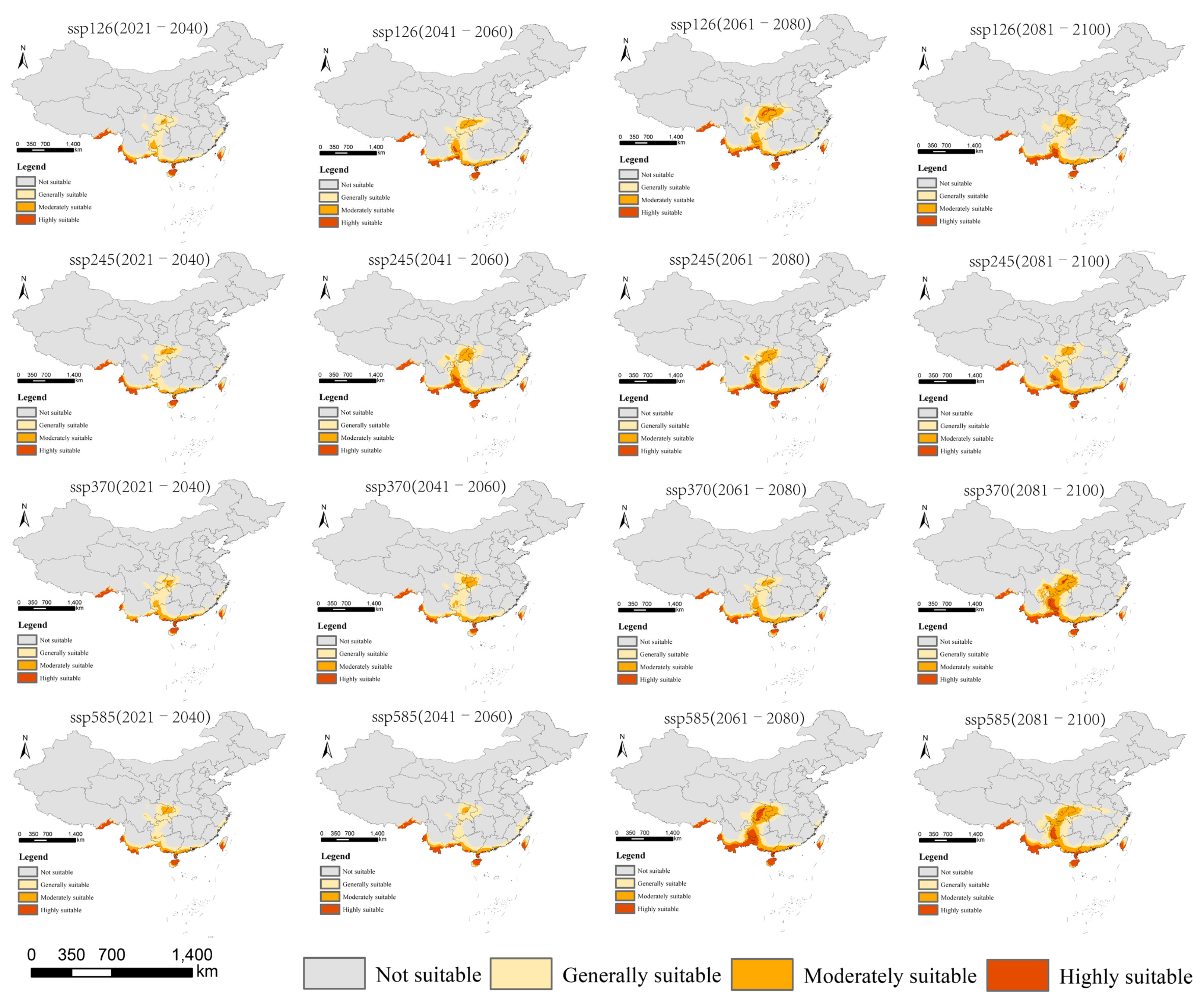
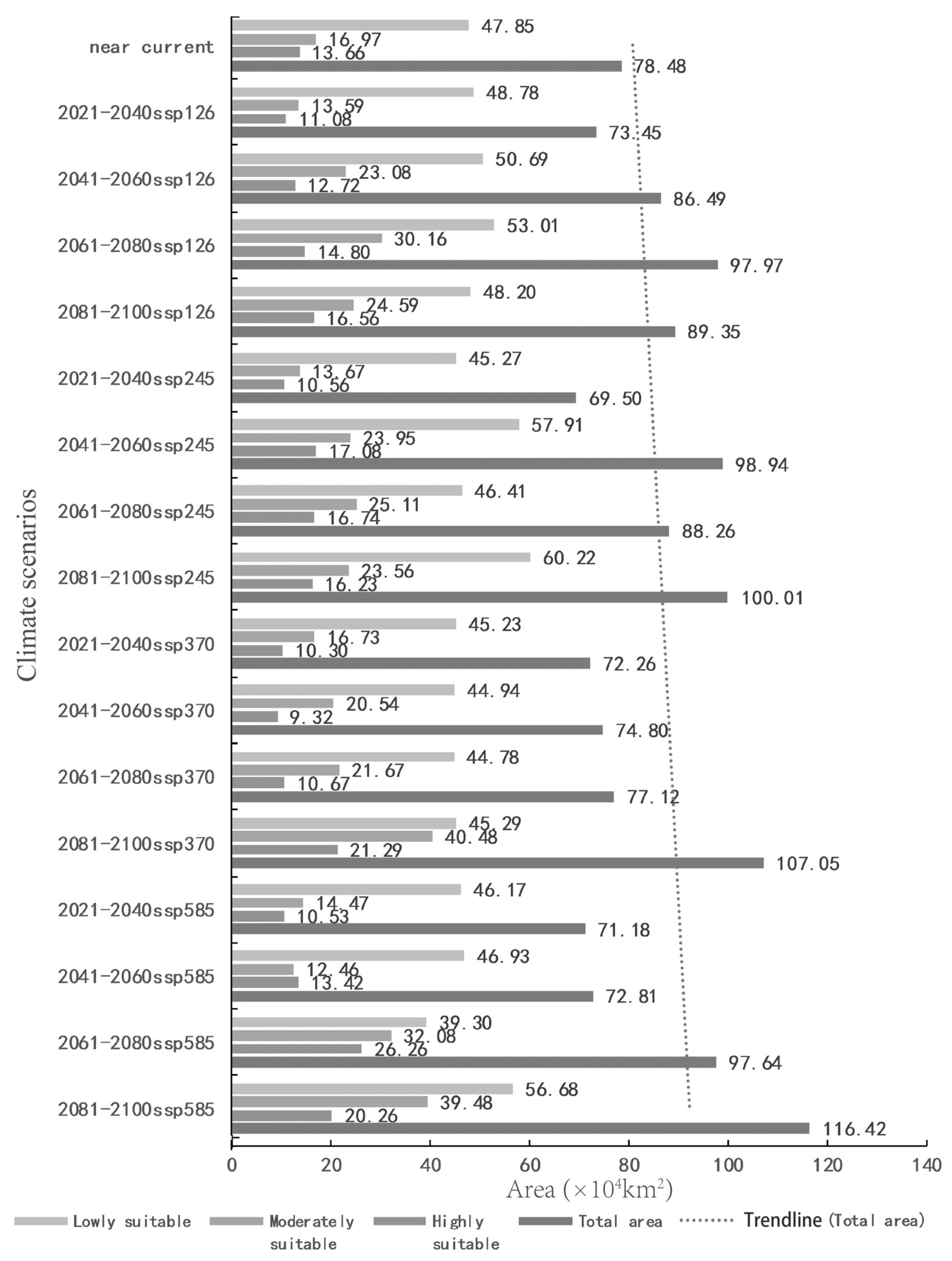


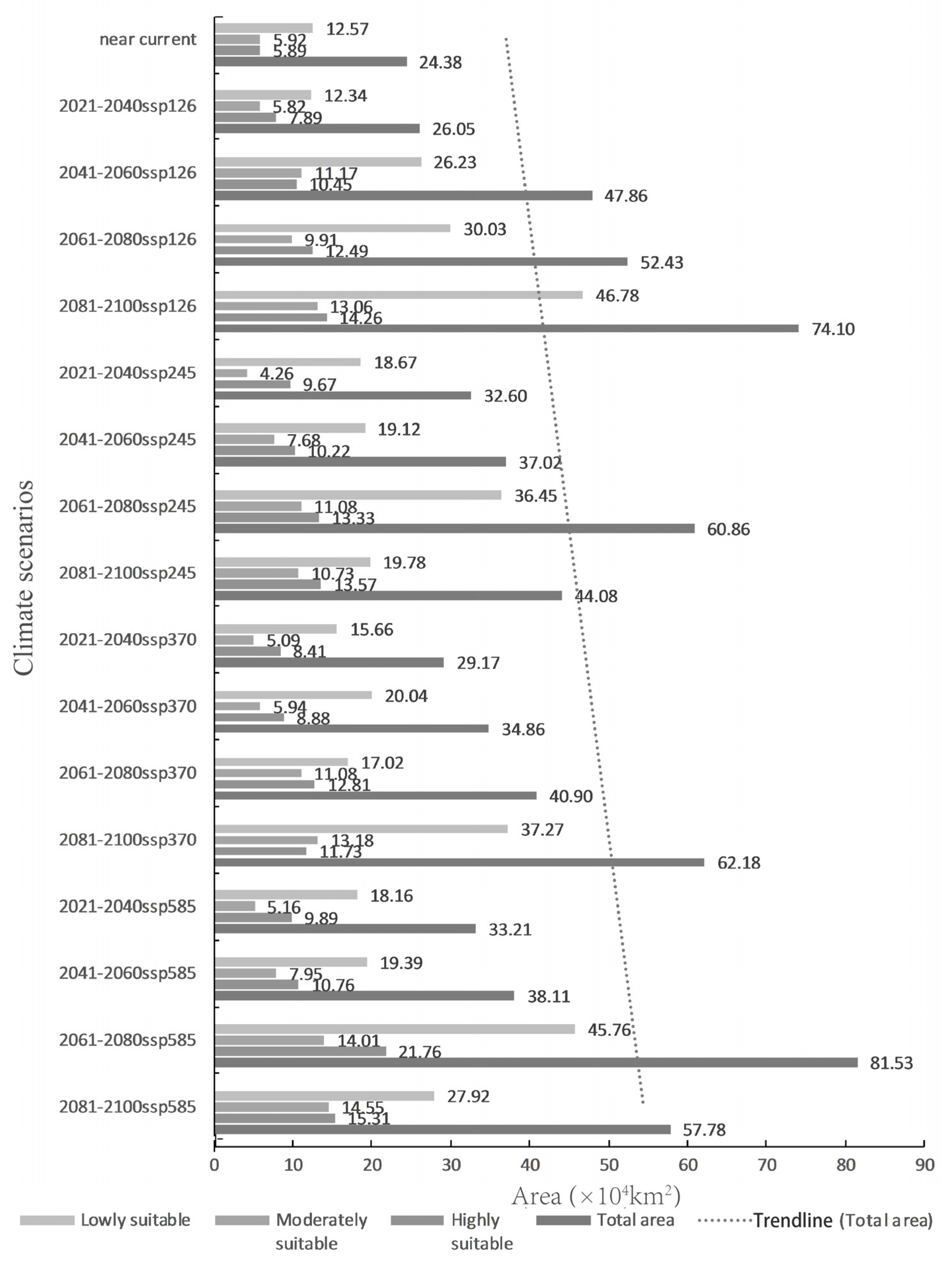
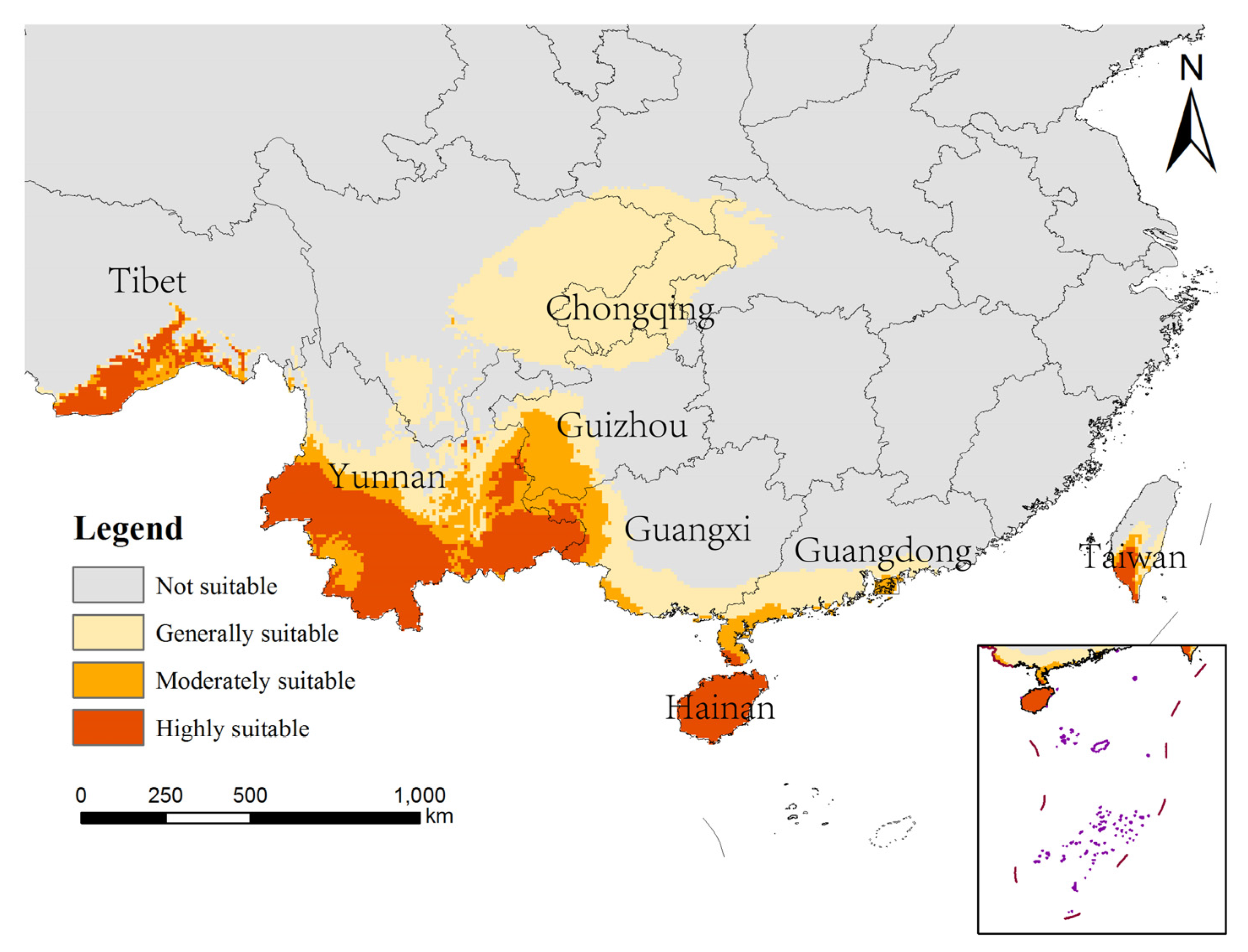
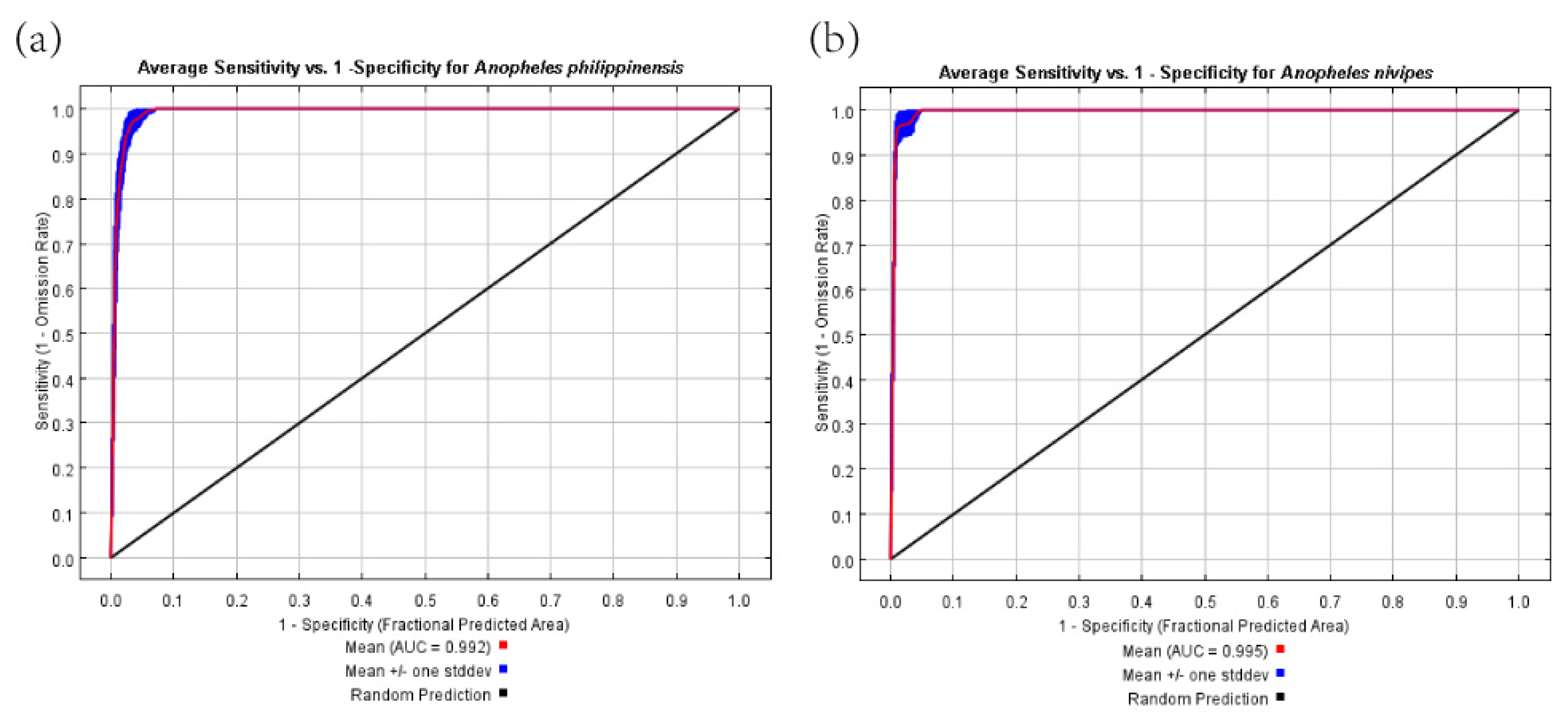
| Symbol | Bioclimatic Variables | Anopheles philippinensis | Anopheles nivipes | ||
|---|---|---|---|---|---|
| Contribution (%) | Permutation Importance | Contribution (%) | Permutation Importance | ||
| Prec9 | Precipitation inSeptember | 46.7 | 6 | 71 | 43.5 |
| Prec5 | Precipitation in May | 35.1 | 64.8 | × | × |
| Bio15 | Precipitation Seasonality | 7.5 | 0.1 | × | × |
| Bio19 | Precipitation of Coldest Quarter | 5.9 | 2.6 | 17.2 | 14.6 |
| Prec12 | Precipitation in December | 2.2 | 0.4 | × | × |
| Prec3 | Precipitation in March | 1.6 | 2 | 6.9 | 6.9 |
| Bio4 | Temperature Seasonality | 1 | 24.2 | 4.3 | 32.9 |
| Species | Project Level | Comprehensive Risk Value | Invasion Risk Level | ||
|---|---|---|---|---|---|
| Introduction Risk (P) | Colonization and Diffusion Risk (E) | Damage Effect (I) | |||
| An. philippinensis | 0.47 | 0.47 | 0.50 | 0.49 | Moderate |
| An. nivipes | 0.42 | 0.41 | 0.51 | 0.44 | Moderate |
Publisher’s Note: MDPI stays neutral with regard to jurisdictional claims in published maps and institutional affiliations. |
© 2021 by the authors. Licensee MDPI, Basel, Switzerland. This article is an open access article distributed under the terms and conditions of the Creative Commons Attribution (CC BY) license (https://creativecommons.org/licenses/by/4.0/).
Share and Cite
Li, C.; Gao, Y.; Chang, N.; Ma, D.; Zhou, R.; Zhao, Z.; Wang, J.; Zhang, Q.; Liu, Q. Risk Assessment of Anopheles philippinensis and Anopheles nivipes (Diptera: Culicidae) Invading China under Climate Change. Biology 2021, 10, 998. https://doi.org/10.3390/biology10100998
Li C, Gao Y, Chang N, Ma D, Zhou R, Zhao Z, Wang J, Zhang Q, Liu Q. Risk Assessment of Anopheles philippinensis and Anopheles nivipes (Diptera: Culicidae) Invading China under Climate Change. Biology. 2021; 10(10):998. https://doi.org/10.3390/biology10100998
Chicago/Turabian StyleLi, Chao, Yuan Gao, Nan Chang, Delong Ma, Ruobing Zhou, Zhe Zhao, Jun Wang, Qinfeng Zhang, and Qiyong Liu. 2021. "Risk Assessment of Anopheles philippinensis and Anopheles nivipes (Diptera: Culicidae) Invading China under Climate Change" Biology 10, no. 10: 998. https://doi.org/10.3390/biology10100998
APA StyleLi, C., Gao, Y., Chang, N., Ma, D., Zhou, R., Zhao, Z., Wang, J., Zhang, Q., & Liu, Q. (2021). Risk Assessment of Anopheles philippinensis and Anopheles nivipes (Diptera: Culicidae) Invading China under Climate Change. Biology, 10(10), 998. https://doi.org/10.3390/biology10100998





